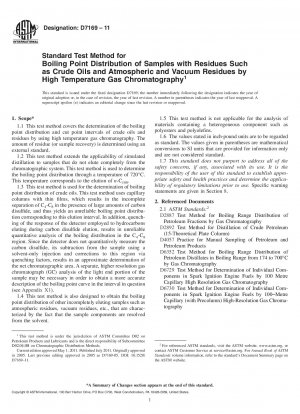ASTM D7169-11
Standard Test Method for Boiling Point Distribution of Samples with Residues Such as Crude Oils and Atmospheric and Vacuum Residues by High Temperature Gas Chromatography
- Standard No.
- ASTM D7169-11
- Release Date
- 2011
- Published By
- American Society for Testing and Materials (ASTM)
- Status
- Replace By
- ASTM D7169-16
- Latest
- ASTM D7169-23
- Scope
The determination of the boiling point distribution of crude oils and vacuum residues, as well as other petroleum fractions, yields important information for refinery operation. These boiling point distributions provide information as to the potential mass percent yield of products. This test method may provide useful information that can aid in establishing operational conditions in the refinery. Knowledge of the amount of residue produced is important in determining the economics of the refining process.
1.1 This test method covers the determination of the boiling point distribution and cut point intervals of crude oils and residues by using high temperature gas chromatography. The amount of residue (or sample recovery) is determined using an external standard.
1.2 This test method extends the applicability of simulated distillation to samples that do not elute completely from the chromatographic system. This test method is used to determine the boiling point distribution through a temperature of 720°C. This temperature corresponds to the elution of n-C100.
1.3 This test method is used for the determination of boiling point distribution of crude oils. This test method uses capillary columns with thin films, which results in the incomplete separation of C4-C8 in the presence of large amounts of carbon disulfide, and thus yields an unreliable boiling point distribution corresponding to this elution interval. In addition, quenching of the response of the detector employed to hydrocarbons eluting during carbon disulfide elution, results in unreliable quantitative analysis of the boiling distribution in the C4-C8 region. Since the detector does not quantitatively measure the carbon disulfide, its subtraction from the sample using a solvent-only injection and corrections to this region via quenching factors, results in an approximate determination of the net chromatographic area. A separate, higher resolution gas chromatograph (GC) analysis of the light end portion of the sample may be necessary in order to obtain a more accurate description of the boiling point curve in the interval in question (see Appendix X1).
1.4 This test method is also designed to obtain the boiling point distribution of other incompletely eluting samples such as atmospheric residues, vacuum residues, etc., that are characterized by the fact that the sample components are resolved from the solvent.
1.5 This test method is not applicable for the analysis of materials containing a heterogeneous component such as polyesters and polyolefins.
1.6 The values stated in inch-pound units are to be regarded as standard. The values given in parentheses are mathematical conversions to SI units that are provided for information only and are not considered standard.
1.7 This standard does not purport to address all of the safety concerns, if any, associated with its use. It is the responsibility of the user of this standard to establish appropriate safety and health practices and determine the applicability of regulatory limitations prior to use. Specific warning statements are given in Section 8.
ASTM D7169-11 Referenced Document
- ASTM D2887 Standard Test Method for Boiling Range Distribution of Petroleum Fractions by Gas Chromatography
- ASTM D2892 Standard Test Method for Distillation of Crude Petroleum (15-Theoretical Plate Column)
- ASTM D4057 Standard Practice for Manual Sampling of Petroleum and Petroleum Products
- ASTM D6352 Standard Test Method for Boiling Range Distribution of Petroleum Distillates in Boiling Range from 174 to 700176C by Gas Chromatography
- ASTM D6729 Standard Test Method for Determination of Individual Components in Spark Ignition Engine Fuels by 100 Metre Capillary High Resolution Gas Chromatography
- ASTM D6730 Standard Test Method for Determination of Individual Components in Spark Ignition Engine Fuels by 100-Metre Capillary (with Precolumn) High-Resolution Gas Chromatography
- ASTM E1510 Standard Practice for Installing Fused Silica Open Tubular Capillary Columns in Gas Chromatographs
- ASTM E594 Standard Practice for Testing Flame Ionization Detectors Used in Gas or Supercritical Fluid Chromatography
ASTM D7169-11 history
- 2023 ASTM D7169-23 Standard Test Method for Boiling Point Distribution of Samples with Residues Such as Crude Oils and Atmospheric and Vacuum Residues by High Temperature Gas Chromatography
- 2020 ASTM D7169-20e1 Standard Test Method for Boiling Point Distribution of Samples with Residues Such as Crude Oils and Atmospheric and Vacuum Residues by High Temperature Gas Chromatography
- 2020 ASTM D7169-20 Standard Test Method for Boiling Point Distribution of Samples with Residues Such as Crude Oils and Atmospheric and Vacuum Residues by High Temperature Gas Chromatography
- 2019 ASTM D7169-19 Standard Test Method for Boiling Point Distribution of Samples with Residues Such as Crude Oils and Atmospheric and Vacuum Residues by High Temperature Gas Chromatography
- 2018 ASTM D7169-18 Standard Test Method for Boiling Point Distribution of Samples with Residues Such as Crude Oils and Atmospheric and Vacuum Residues by High Temperature Gas Chromatography
- 2016 ASTM D7169-16 Standard Test Method for Boiling Point Distribution of Samples with Residues Such as Crude Oils and Atmospheric and Vacuum Residues by High Temperature Gas Chromatography
- 2011 ASTM D7169-11 Standard Test Method for Boiling Point Distribution of Samples with Residues Such as Crude Oils and Atmospheric and Vacuum Residues by High Temperature Gas Chromatography
- 2005 ASTM D7169-05 Standard Test Method for Boiling Point Distribution of Samples with Residues Such as Crude Oils and Atmospheric and Vacuum Residues by High Temperature Gas Chromatography
